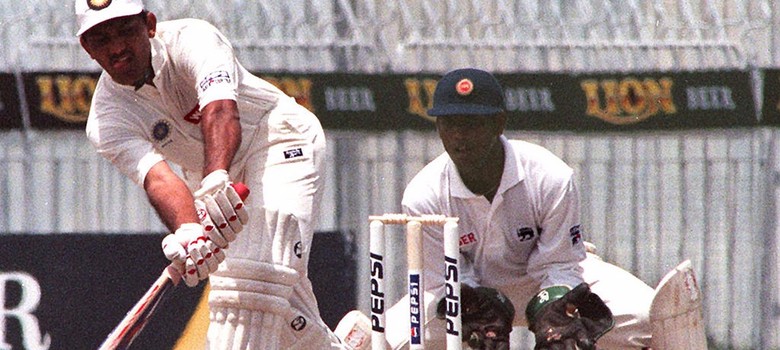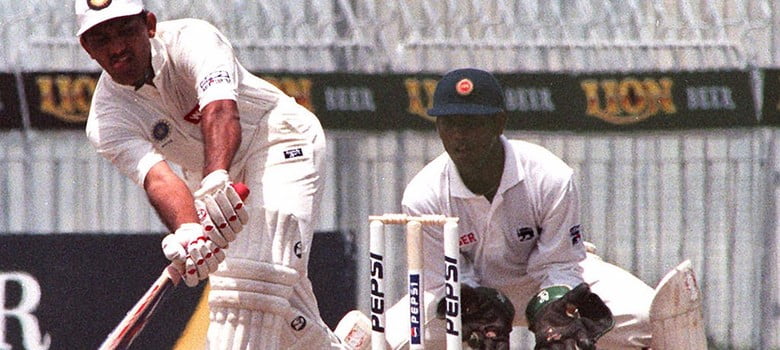
There is something about Hyderabad that gives its cricketers their characteristic lazy elegance. When the bat is their hands, cricket ceases to be a power game. It becomes a game of gentleness, joviality and civility.
Before VVS Laxman came another magician from the city of nawabs – Mohammed Azharuddin, a man with a brooding face and permanently furrowed brows.
And those wrists.
With one flick of his wrists, the bat would meet the ball, sometimes in mid-turn, and speed away – never in anger, but in refinement. Like the great Gundappa Viswanath before him, and Laxman after him, Azharuddin was an artist at the crease.
And yet it all fell away. Not many Indian cricketers have the fortune of being the subject of a biopic, but Azharuddin is one of them. This summer will see the release of Azhar, starring Emraan Hashmi and directed by Tony D’Souza. But it is unlikely the movie will focus much on Azharuddin’s cricketing exploits. It will probably dwell on the colourful life of one of Indian cricket’s most enigmatic personalities.
On top of the world
At his peak, there was no equal. Between the ’80s when he made his debut with three consecutive centuries in his first Tests, till the late 1990s, Mohammad Azharuddin had the world at his feet. He received the Arjuna Award in 1986. The English soon noticed his talent. “It’s no use asking an Englishman to bat like Mohammad Azharuddin,” said John Woodcock, the well-known English cricket writer. “It would be like expecting a greyhound to win the Epsom Derby.”
The Sachin Tendulkar era had already started but Azharuddin had marked out his space. For many young cricket fans, Tendulkar was the epitome of perfection, but Azharuddin was the embodiment of elegance. His artistry on the field had an ageless grace no other cricketer had. His stoic, brooding demeanour added to the sense of enigma about him. While others celebrated after India’s on-field victories, he was the battle-scarred veteran who ensured that success and failure were treated the same. Whatever the result, Azharuddin’s expressions hardly changed. His “boys played well” comment after an India win became a standing joke. If cricket journalists today find skipper Mahendra Singh Dhoni’s cryptic comments annoying, they would have perhaps had an apoplectic fit trying to get Azharuddin to talk.
The gossip column
For all his on-field restraint, Azharuddin lived a colourful life off it. India’s staid media was changing after 1991, and he was perfect fodder for tabloids. Columns were devoted to his second marriage, to Bollywood actress Sangeeta Bijlani. Cricket and Bollywood have always made for eye-grabbing headlines but Bijlani’s earlier engagement to a certain Salman Khan made the new couple even more gossip-worthy.
On the field, Azharuddin carried on playing. The Indian selectors have always played musical chairs with the captaincy, and the trend continued with Azharuddin. By the late ’90s, he swapped the captaincy with Tendulkar a few times, but no one expected him to be dropped from the team.
Azharuddin soon neared the elite 100-Test mark. The script seemed predictable – He would play his 100th Test, and announce his retirement.
But that was not to be.
The nowhere man
On June 15, 2000, former South Africa captain Hansie Cronje, facing charges of match-fixing, deposed before the King Commission of inquiry.
As much of the suspicion revolved around the just concluded South African tour of India, many assumed that there would be an Indian involvement, but few believed it would run very deep.
“On the evening of the third day of the third Test against India in Kanpur, I received a call from Azharuddin,” began Cronje. “He called me to a room in a hotel and introduced me to Mukesh Gupta [a bookie], otherwise known as MK. Azharuddin then departed and left us alone in the room.”
And with that short statement, Azharuddin had been clean bowled.
At first, the Board of Control for Cricket in India was guarded in its reaction. But when the Central Bureau of Investigation found Azharuddin guilty of fixing the result of matches, it banned him for life, as did the International Cricket Council.
Azharuddin denied the allegations against him, perhaps making his case worse by claiming that he was being targeted because he belonged to a minority community. But few bought his story.
The cricketer was no longer known for his wristy stroke play. He was seen as a corrupt scoundrel who had desecrated the gentleman’s game. He would remain stranded on 99 Tests, tantalisingly out of reach of the greatness that had once seemed his destiny.
His legacy
It is particularly interesting to compare Azharuddin’s fate with that of his teammate Ajay Jadeja.
Jadeja was banned for five years in 2000 for match-fixing, but the Delhi High Court overturned the ban in 2003. Jadeja went on to become a well-respected cricket commentator and even made a return to the Ranji Trophy. There was no trace of those dark days – it was as if he had never been convicted.
Azharuddin was not so lucky. His case dragged on, and though the Board of Control for Cricket in India revoked his ban in 2006, he remained an outcast.
Politics came calling soon after, and the former Indian captain became a Member of Parliament on a Congress ticket from Moradabad in 2009.
After his electoral victory in Moradabad, his personal life continued to draw attention as reports of his divorce with Bijlani emerged. In 2011, his youngest son Ayazuddin was killed in a bike accident in Hyderabad.
Azharuddin got some relief in 2012 when the Andhra Pradesh High Court set aside his life ban. But he was 49 at the time and too old to get back on the pitch.
Azharuddin will undoubtedly merit a chapter in the history of Indian cricket, but his portrayal won’t be flattering. The man who commodified the gentleman’s game, the man who sold his country out, are just some of the descriptors likely to be attached to his legacy.
But one image can never really be erased. A scowling, much-younger Azharuddin – head bent, brows furrowed, bat at an angle – observing the red ball scoot to the mid-wicket boundary.
[“source-Scroll”]




